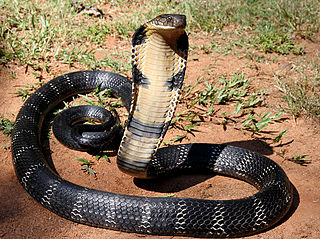Related Research Articles

The king cobra is a venomous snake endemic to Asia. With an average length of 3.18 to 4 m and a maximum record of 5.85 m (19.2 ft), it is the world's longest venomous snake. Colouration of this species varies across habitats, from black with white stripes to unbroken brownish grey. The sole member of the genus Ophiophagus, it is not taxonomically a true cobra, despite its common name and some resemblance. The king cobra inhabits forests from South to Southeastern Asia where it preys chiefly on other snakes, including those of its kind. A female king cobra builds a nest to hold its eggs which will be protected throughout the incubation period.
Ophanin is a toxin found in the venom of the King Cobra, which lives throughout South East Asia. This toxin belongs to the cysteine-rich secretory protein (CRISP) family. Ophanin weakly blocks the contraction of smooth muscles elicited by high potassium-induced depolarization, suggesting that it inhibits voltage-dependent calcium channels.
Adamalysin is an enzyme. This enzyme catalyses the following chemical reaction

In enzymology, an L-amino acid oxidase (LAAO) (EC 1.4.3.2) is an enzyme that catalyzes the chemical reaction
Bothropasin is an enzyme. This enzyme catalyses the following chemical reaction
Leucolysin is an enzyme. This enzyme catalyses the following chemical reaction
Atrolysin B is an enzyme. This enzyme catalyses the following chemical reaction
Atroxase is an enzyme. This enzyme catalyses the following chemical reaction
Atrolysin E is an enzyme. This enzyme catalyses the following chemical reaction
Atrolysin F is an enzyme. This enzyme catalyses the following chemical reaction
Horrilysin is an enzyme. This enzyme catalyses the following chemical reaction
Ruberlysin is an enzyme. This enzyme catalyses the following chemical reaction
Bothrolysin is an enzyme. This enzyme catalyses the following chemical reaction
Trimerelysin I is an enzyme. This enzyme catalyses the following chemical reaction
Trimerelysin II is an enzyme. This enzyme catalyses the following chemical reaction
Mucrolysin is an enzyme. This enzyme catalyses the following chemical reaction
Fibrolase is an enzyme. This enzyme catalyses the following chemical reaction
Jararhagin is an enzyme. This enzyme catalyses the following chemical reaction
Curcuma zedoaroides, locally named in Thai as Wan-paya-ngoo-tua-mia, was first described by Chaveerach et al. in 2008. The plant is cultivated in the King Cobra Village of Khon Kaen Province, northeastern Thailand, where it is commonly used as a snake-bite antidote. Lattmann et al. (2010) and Salama et al. (2012) have published the antivenom activity of some phytochemical compounds isolated from plant rhizomes extract against Ophiophagus hannah.
Long neurotoxin 1 (LNTX-1) is a neurotoxin that binds antagonistically to all types of muscular and neuronal nicotinic acetylcholine receptors. LNTX-1 is found in the venom of the king cobra.
References
- ↑ Yamakawa Y, Omori-Satoh T (1988). "A protease in the venom of king cobra (Ophiophagus hannah): purification, characterization and substrate specificity on oxidized insulin B-chain". Toxicon. 26 (12): 1145–55. doi:10.1016/0041-0101(88)90299-1. PMID 3070833.